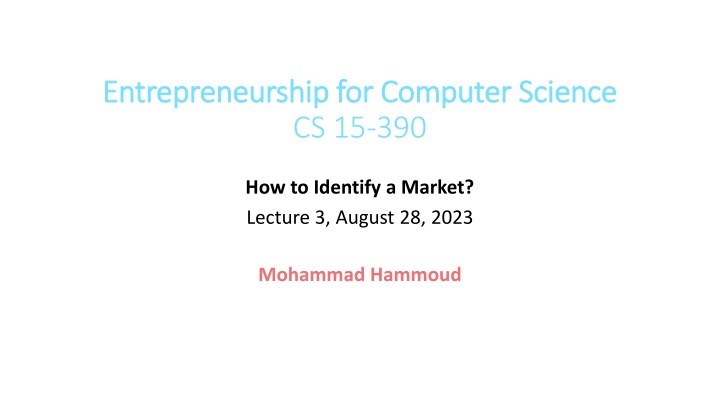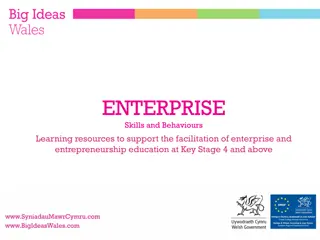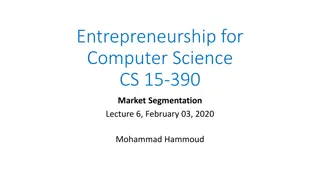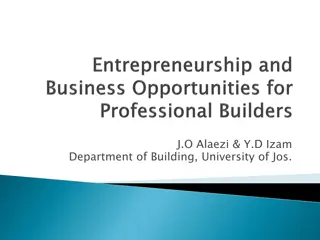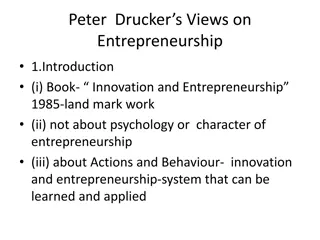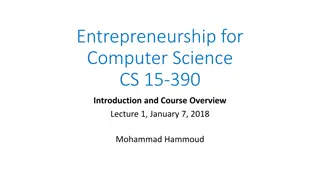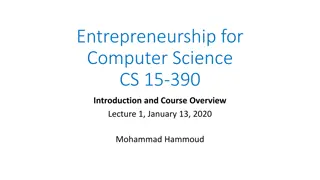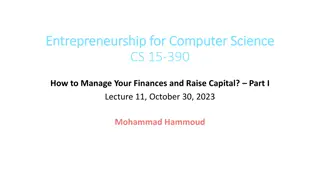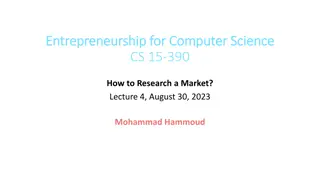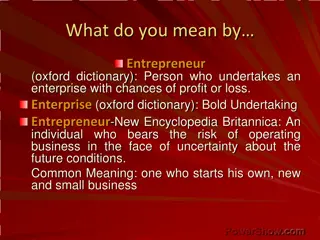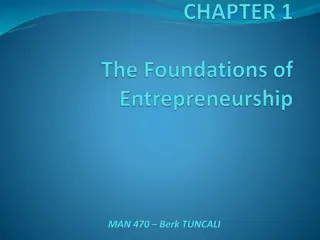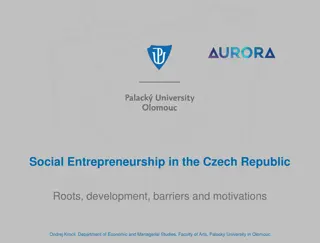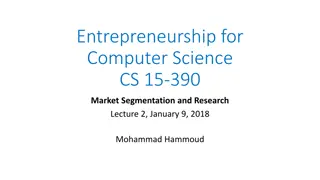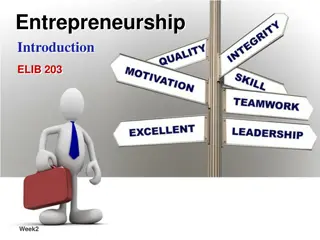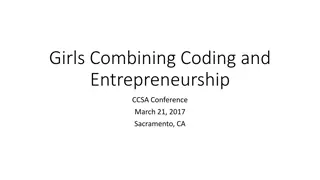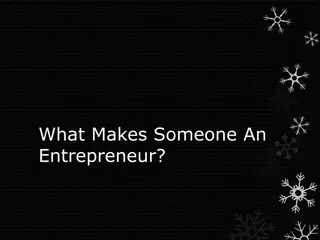Mastering Market Identification in Entrepreneurship for Computer Science
Delve into the lecture on how to identify a lucrative market in the realm of Entrepreneurship for Computer Science. Explore the significance of location, research methodologies, and key principles for market identification. Uncover the power of strategic positioning and the essential role it plays in driving entrepreneurial success.
Download Presentation

Please find below an Image/Link to download the presentation.
The content on the website is provided AS IS for your information and personal use only. It may not be sold, licensed, or shared on other websites without obtaining consent from the author.If you encounter any issues during the download, it is possible that the publisher has removed the file from their server.
You are allowed to download the files provided on this website for personal or commercial use, subject to the condition that they are used lawfully. All files are the property of their respective owners.
The content on the website is provided AS IS for your information and personal use only. It may not be sold, licensed, or shared on other websites without obtaining consent from the author.
E N D
Presentation Transcript
Entrepreneurship for Computer Science Entrepreneurship for Computer Science CS 15-390 How to Identify a Market? Lecture 3, August 28, 2023 Mohammad Hammoud
Today Last session: The birth of great ideas The two types of entrepreneurship How to conceive a great idea? Principle 1: Know your why Today s session: How to identify a market? The power of location Principle 2: Be Where the Heat of the Action Is Principle 3: Go In Through the Side Door or the Vast Gate Announcements: Email me your team (the names) by 11:59PM today Quiz I will be on Monday, September 04
Entrepreneurship Paradigm A System of Functions Paradigm: Functions Identify & Research a Market Found or Co-found a Company Build a Business Model Identify a Problem Build a Prototype Bootstrap and/or Raise Angle Fund Raise Market & Operate Build a Culture Build an MVP Professional Money Scale Exit
Entrepreneurship Paradigm A System of Functions Paradigm: Functions Identify & Research a Market Found or Co-found a Company Build a Business Model Identify a Problem Build a Prototype Bootstrap and/or Raise Angle Fund Raise Market & Operate Build a Culture Build an MVP Professional Money Scale Exit
Outline How to Identify Your Market? How to Research Your Market?
The Power of Location It s all about location is a maxim that has defined almost every industry E.g., In real estate, location is the single most important factor in determining the value of a home A beautiful 4-bedroom house on the top of a hill overlooking San Francisco Bay might worth many millions of dollars Same house, with the same amount of land, moved to the bottom of that hill, next to a fire station, and it will worth only half as much, if you re lucky! How to think about location?
The Power of Location The logic goes as follows: If you are playing soccer, it is probably a good idea to be in Europe (e.g., In England, Spain, or France) If you are in acting, it is probably a good idea to be in Hollywood If you are in design and fashion, it is probably a good idea to be in New York City, London, Millan, or Paris If you are in technology, it is probably a good idea to be in _____?______ As a founder of a startup, it is your job to figure out where you belong for your business to reach its full potential For Tobi Lutke, the founder of Shopify, the place was Ottawa, Ontario For Katrina Lake, the founder of Stitch Fix, the place was Silicon Valley
Principle 2 Principle 2: Be Where the Heat of the Action Is Andrew Houston, the founder of Dropbox, said in his commencement address at MIT in 2013: Where you live matters whatever you re doing, there is usually only one place where the top people go. You should go there. Don t settle for anything else If real action is happening somewhere else, move A mango tree can grow in a tropical weather Can it grow in a cold weather? How to choose where to start and grow your startup?
Principle 2 Principle 2: Be Where the Heat of the Action Is At least 10 factors to consider: 1. Access to resources (e.g., Capital, talents, etc.,) 2. Regulations 3. Tax laws 4. Optics 5. Concentration of other startups Positive Spillover (based on a research study by Dylan Minor in the Kellogg School of Management at Northwestern University) If Bill is rated high for speed or quality and Bob is rated low, Bob s speed or quality will improve by 15% when he sits within a 25-foot radius from Bill And, crucially, Bill s speed or quality will NOT be dragged down by Bob s The Positive Spillover phenomenon applies to startups as well (not only to people)
Principle 2 Principle 2: Be Where the Heat of the Action Is At least 10 factors to consider: 6. Space options (for the company and the employees) 7. Transportation options and parking 8. Proximity to other businesses and services (always aim to enrich the quality of your company as a workplace) 9. Market size In military operations, if an army wants to invade an enemy territory, the army may employ a beachhead strategy, which entails planning and focusing all the time and resources on wining a small strategic boarder area (i.e., the beachhead market) The beachhead market then becomes the stronghold to land troops and supplies for the bigger invasion (which the market should allow) to the enemy territory E.g., The 1944 invasion of Nazi-controlled Europe by the Allied forces 10. Competition ( diminishing returns rise with increased competition)
Principle 3 Principle 3: Go In Through the Side Door or the Vast Gate Peter Thiel said in a 2014 lecture titled Competition is for Losers at the Stanford Center for Professional Development: Don t always go through the tiny little door that everyone s trying to rush through. Go around the corner and go through the vast gate that no one s taking. If you aren t doing something completelynovel or you aren t doing it in a totally new way or new place, you should think long and hard about how to be in a market E.g., 5-hour Energy, which owns today more than 93% share of the energy shot business in USA
Principle 3 Principle 3: Go In Through the Side Door or the Vast Gate How did Manoj Bhargava, the founder of 5-hour Energy, do it? If I make another [energy] drink, I ve got to fight for space in the cooler against Red Bull and Monster [Energy]. I ve also got to fight Coke, Pepsi, and Budweiser for space. So you re pretty much dead if you want to try that. Then, it dawned to him: If I m tired, why am I thirsty also? By which he meant, why should we have to chug 10 to 16 ounces of a cloyingly sweet liquid in order to get an energy boost He added: It would be like Tylenol selling 16-ounce bottles This was 5-hour Energy s side door It wasn t a drink, so it wasn t an immediate threat to Red Bull or Monster Energy It was a 2-ounce vitamin for the brain that did not need to be refrigerated or given a large, dedicated shelf, hence, retailers didn t have to worry about space It just belonged there (at the cash register!)
Principle 3 Principle 3: Go In Through the Side Door or the Vast Gate How did Manoj Bhargava, the founder of 5-hour Energy, do it? He started at the largest vitamin store, GNC (hisgo-to-market strategy) Much less competition compared with grocery and convenience stores It turns out GNC is always looking for new products, because once a product gets mass distribution, GNC is sort of out of it If it s in Walmart, nobody s going to buy it at GNC. Then, he went to drugstores like Walgreens and Rite Aid Today, 5-hour Energy is near the cash register of almost every store in the USA Coca-Cola, PepsiCo, Monster Energy, and Red Bull flooded the market with their own 2-ounce-shot offerings... and failed!
Principle 3 Principle 3: Go In Through the Side Door or the Vast Gate How was it for Microsoft? It was their revolutionary flagship product, the Windows OS, which turned into a toll bridge that every PC maker had to cross if they expected consumers to buy their machines The GUI of Windows made it so popular, which had the additional effect of creating a moat between Microsoft and its competitors This was Microsoft s vast gate
Principle 3 Principle 3: Go In Through the Side Door or the Vast Gate Peter Thiel went on saying in his 2014 lecture: if you re the founder-entrepreneur starting a company, you always want to aim for monopoly, and you always want to avoid competition. You want to be the only one directing traffic and collecting tolls across the wildest moat possible Note: Just make sure when you get there, you don t become what you fought so hard against!
Next Class How to research a market?
